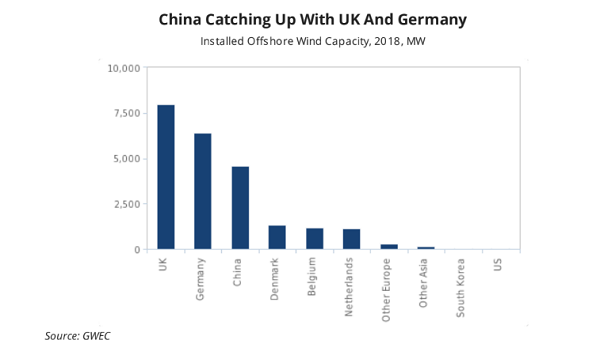
China closes in on Europe for offshore wind dominance
Guandong province alone targets 12GW offshore wind by 2020.
Even though China is a relative new-comer in the offshore wind power segment, the rapidly falling offshore wind power costs in Western Europe and the rising competitiveness of the technology in markets such as the United States and Taiwan is expected to push China to substantially boost offshore wind power capacity over the coming decade, says Fitch Solutions.
This trend is forecast to also be the result of efforts to decarbonise power supplies closer to coastal consumption hubs and boost Chinese technological expertise, to eventually enable the export of technology.
Also read: China's wind capacity to double to 421GW by 2028
China’s sighted leadership in the offshore wind segment is specifically seen to manifest in the provinces of Guangdong and Jiangsu, where offshore wind capacity deployments are most accelerated. In particular, the Guandong provincial offshore wind development plan has targeted 2GW of offshore wind capacity installations and a further 12GW is set to be constructed by the end of 2020.
Since 2015, China's offshore wind capacity has seen its total installed capacity grow from 9% as of end- 2015, to more than 25% by 2018. Fitch forecasts that such trend will further continue eventually launch China’s offshore wind in the global scene.
Whilst the foresight in China’s position is increasingly positive, Fitch sees potential roadblocks such as cost reductions for offshore wind power and policy transitions in the segment.
Trimming of costs for offshore wind power over the coming two years will be a key pre-occupation of Chinese offshore wind developers amidst the broader phase-out of renewables subsidies in the market. After years of attractive feed-in-tariffs for onshore wind and photovoltaic solar power projects, substantial renewables generation curtailment has led to a FiT payment backlog surpassing $18b, which has resulted to rising concerns over the economic sustainability of China's renewables subsidy mechanism, the report read.
This has led Beijing to transition away from the FiT scheme to zero-subsidy renewables for onshore wind and PV solar by 2021, while offshore wind projects are required to be below the old FiT rate of $133/MWh. The latter move is sighted to pose a risk to some of China's burgeoning offshore wind project pipeline, which likely will be required to cut costs beyond what was expected before this policy alteration.
China’s aspirations to stimulate offshore wind cost deflation towards becoming subsidy-free already by 2022 is expected to cement a push for the country to cut costs across the offshore wind supply chain, adopt more modern wind turbine technology, optimise operation & maintenance and target the most competitive wind sites. Chinese companies Dongfang Electric and CSIC Haizhuang have both unveiled 10MW offshore wind turbines in 2019.























 Advertise
Advertise







